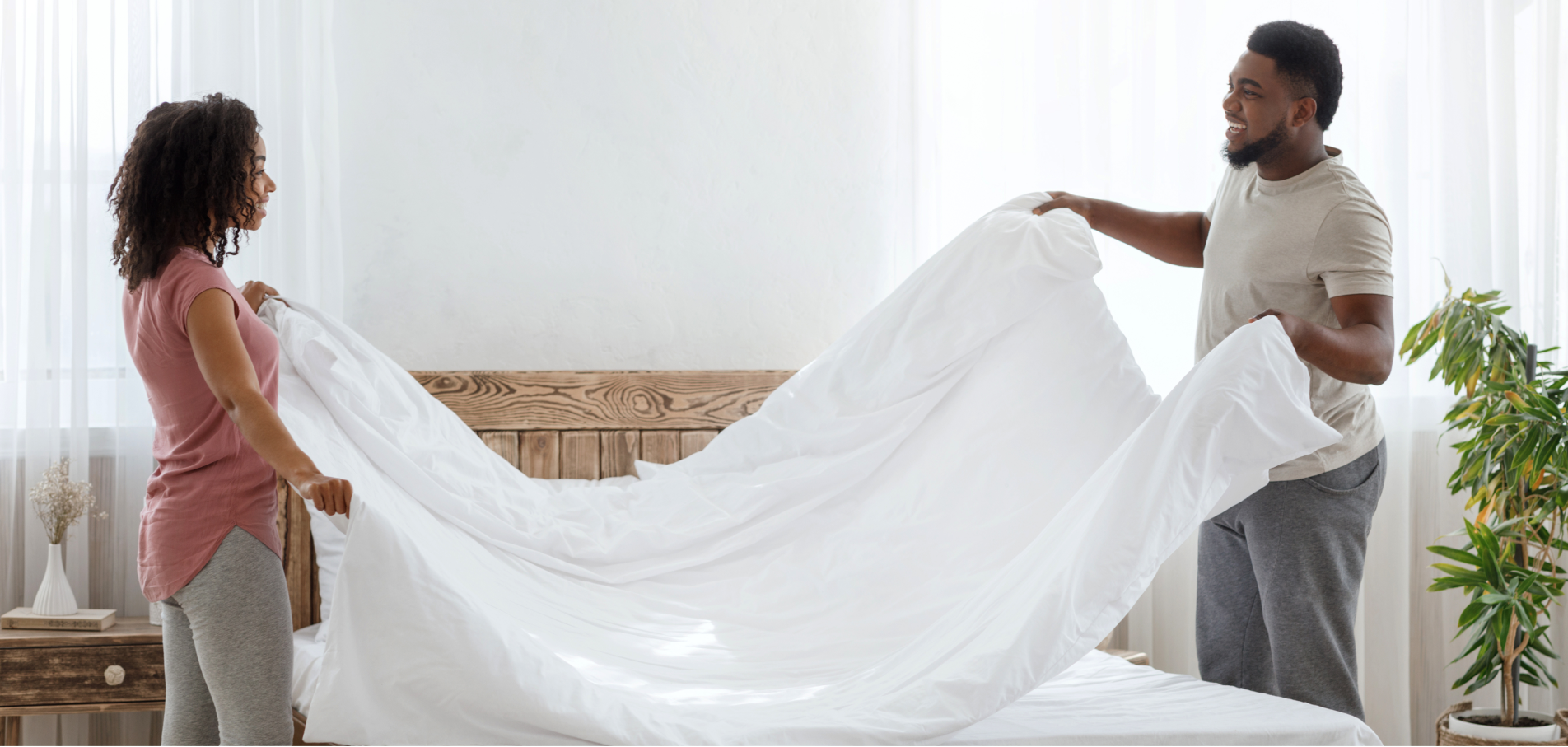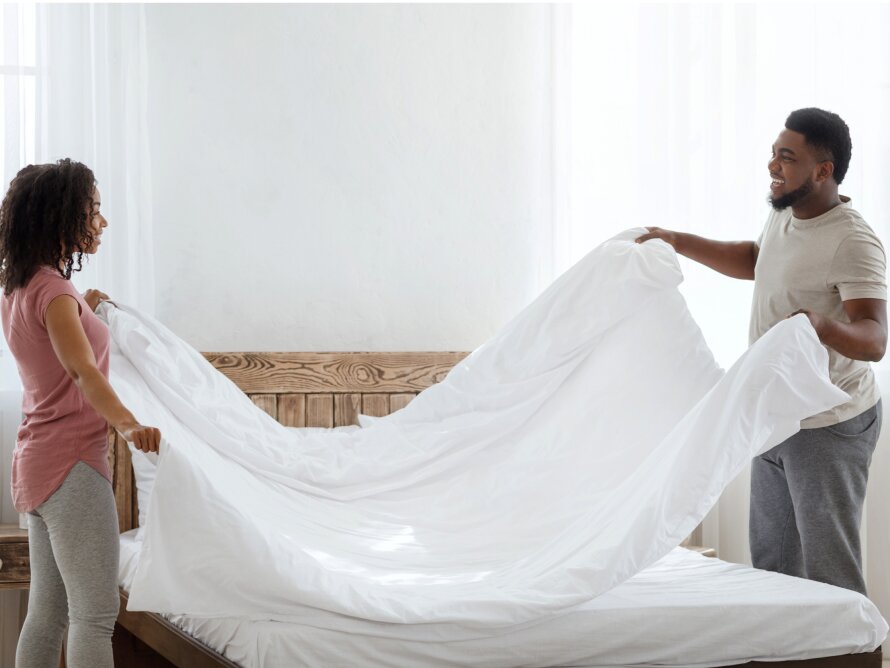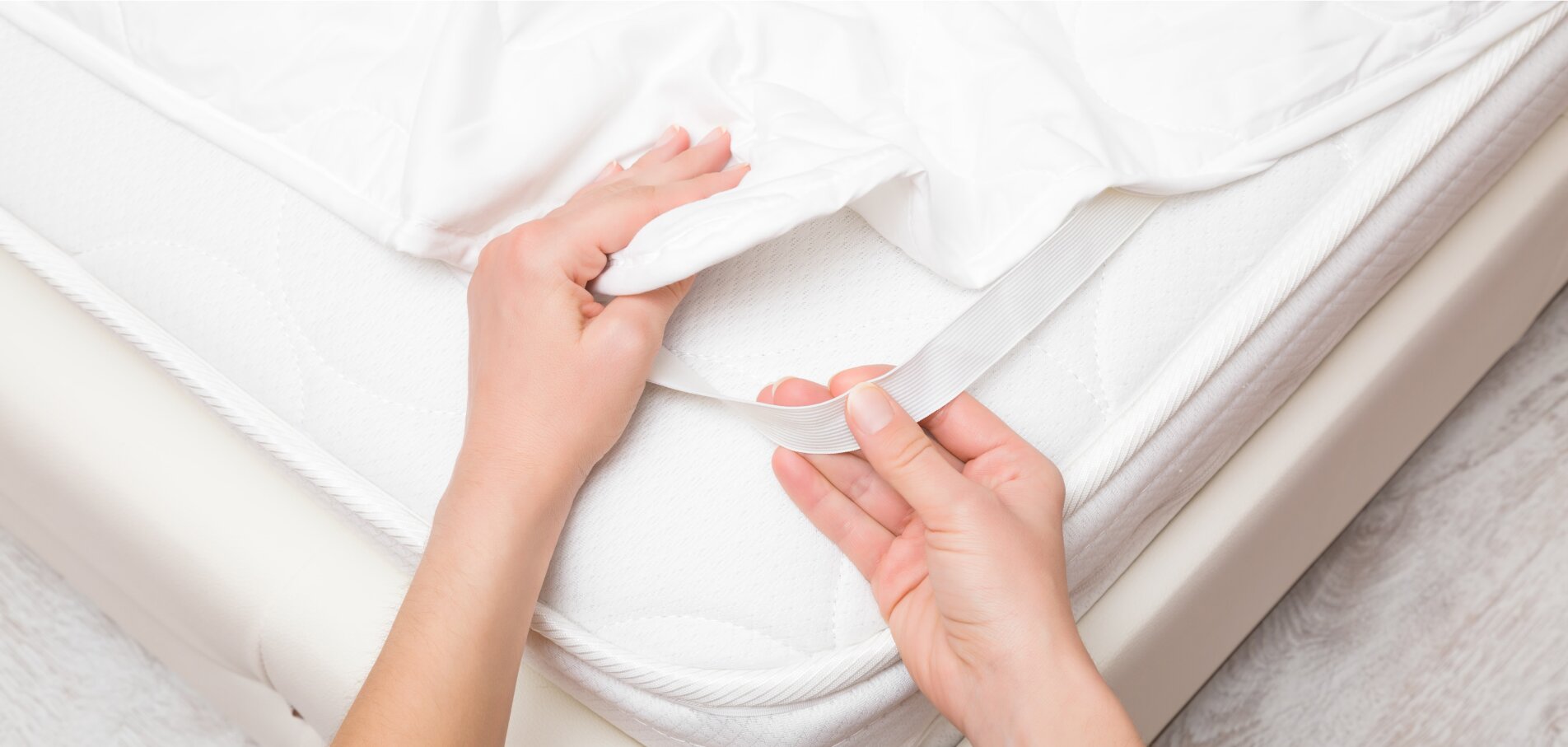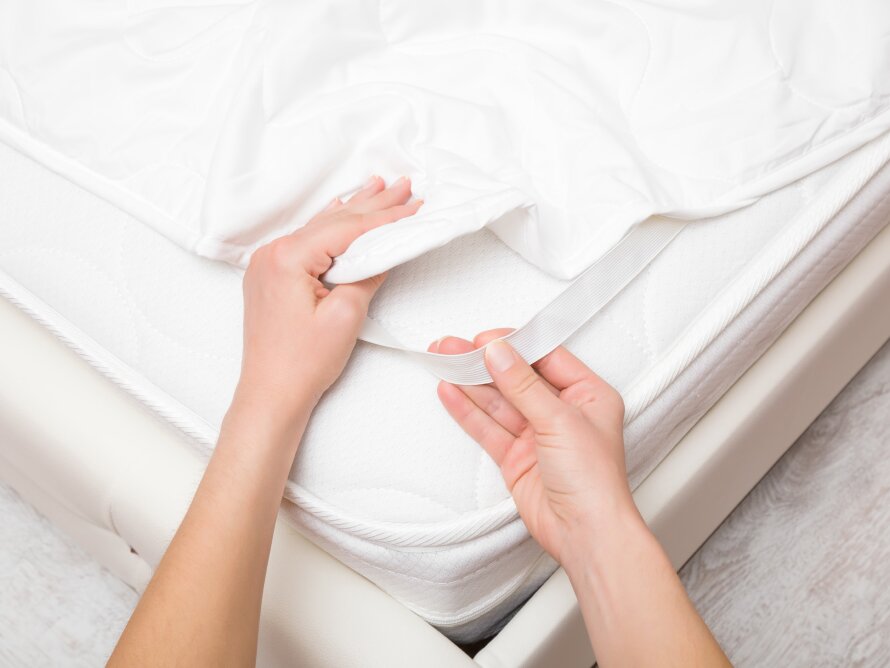You're on the list
By signing up, you agree to receive email marketing.


A tidy house makes for a tidy mind—and nothing helps start the day better than making your bed each morning. Evidence has found that making your bed increases productivity, improves focus, and reduces stress. And what’s more, learning how to make your bed can also improve your sleep!
Continue reading to learn our six simple steps to make your bed (as well as tips on crafting the coziest sleep environment!)
If you’re looking for added support and cushion, a mattress pad, topper, or both may be what you’re seeking. While a mattress pad gives protection and a little support, a topper provides extra cushion to add comfort to your good night’s rest.


If your mattress topper has no non-slip bottom, consider adding a non-slip pad on top of your mattress, which will help secure the topper. This pad will reduce movement while you sleep.
Align the topper or pad with the four corners of your mattress. If your pad has a stretch skirt, pull it over the edges, ensuring all sides are tucked in.
To find the best fit for your preferences, it's best to examine each type, their features, and the support they provide for every sleeping situation.
Mattress pads are commonly made of latex, fiber, or feathers.
Mattress toppers can also range from latex to feather. But toppers made of wool and memory foam have become popular options.
A mattress pad is typically a thin, quilted layer, making them machine washable. Many mattress pads feature a stretch skirt or elastic edges to secure on all sides of the bed. Most mattress pads today come with a dual purpose as a pad and protector. Choosing a hypoallergenic option will protect your mattress from allergen and bacteria build-up, spills, and stains.
Mattress toppers have a thickness that ranges from 2-4 inches, and they naturally protect your mattress from spills and stains and increase its longevity. If your mattress topper comes with a cover, they are machine washable. If not, the topper can only be spot-cleaned if you go without a cover.
Some high-quality toppers also have a cooling feature designed to regulate
If you’re looking for light support and slight cushioning while keeping the firm essence of your mattress, a mattress pad would suit your needs.
A mattress topper provides a thicker layer of comfort on top of your mattress and more support, depending on the material. To keep it from shifting while you sleep, we recommend looking at toppers with built-in viscoelastic bottoms or purchasing a non-slip pad to place underneath.
The fitted sheet goes over your mattress topper or pad. This layer acts as the base layer sheet and security guard that keeps everything underneath in place.
Lay the fitted sheet on your bed, aligning the four corners.
Starting in one corner, tuck the sheet under the mattress.
We recommend moving to the corner diagonally from your starting corner. It would make it easier to tuck in the last two corners.
Repeat tucking in the last two corners.
Smooth out any bunches by pulling the fitted sheet taut over your mattress.
We recommend purchasing the correct size sheets for your bed, or extra material will slacken over the edges. With so many kinds of bed sheet sets and fabrics offered, consider these features when shopping.
Basic sheet sets for full-size and larger mattresses include one fitted sheet, one flat sheet, and two pillowcases. Twin-size mattresses are the same, apart from providing only one pillowcase. All-inclusive sets can also include a matching comforter and a set of shams.
If you’re looking for a fabric that helps regulate your body’s temperature throughout the night and is hypoallergenic, we recommend silk sheets. Linen sheets are lightweight and made from all-natural fibers, providing moisture-wicking comfort. Flannel sheets are the best bed sheets that keep you warm and cozy throughout chilly nights, while microfiber and cotton sheets are durable materials and have easy clean up for messes and stains.
Believe it or not, the difference in comfort may be coming from your sheet’s weave type and thread count. The most popular weaves are:
Percale: Providing a crisp and cool feel
Sateen: Known for its soft feel and attractive sheen
Twill: Durable and used on studier fabrics like flannel and wool
When it comes to thread count, sheets with a lower thread count are more breathable and better suited for hot sleepers, while a higher thread count is better suited for durability and a soft touch, but it is more expensive.
Flat sheets act as a protective layer between you and your top layer (i.e., duvet, comforter, or quilt).
Lay the flat sheet upside down on your bed, the thicker hemmed edge toward the headboard.
Center the sheet on your mattress, distributing it equally on both sides and at the end of the bed.
Tuck in the bottom edge beneath the mattress.
Like folding the ends of a present, tuck in the corners at the end of the bed to the sides.
Fold the sides of the flat sheet over the tucked corners and tuck under the mattress.
For the top portion, you can fold it two ways: One, you tuck it in like the bottom edge. Two, you can fold it over to display the right side of the sheet.
Shop Sheets & PillowcasesA comforter or duvet is the top layer when making your bed. Insulation materials fill a comforter, and their seams are sewn closed with a decorative cover. Comforters come in various designs to complement the style you envision for your bedroom space. Duvets are usually found in the shape of a large white bag, its filling secured by buttons or zippers.
Lay the comforter or duvet on top of your bedding in the same orientation as your bed, making sure you center it so there’s an equal amount of material on each side.
Tuck in the top layer if you prefer a tight look, or leave it loose for a casual style.
Another styling option: Fold your comforter or duvet into thirds, laying the top edge on top.
While a comforter is a single piece, the duvet consists of two pieces: an insert and a cover.
A comforter is seen as a ready-to-go styling piece, but the duvet’s cover can be interchanged when styles and designs change.
Duvets are loftier than comforters when it comes to their presence in the bedroom.
Sizes of duvets and comforters are different from one another.
Shop Comforters & DuvetsNow that your bed sheets and blankets have been set, it’s pillow time. While some like to keep it clean and simple with one to two pillows, others use their pillow arrangements to complement the style of their room.
If you like to keep things simple but would like to add charm to your bed arrangement, we suggest this simple styling:
Grabbing the sides of your pillows, squeeze and pull them together in a pulse-like motion to distribute the interior filling evenly (unless it is a one-piece memory foam pillow). Fluffing any pillow with light material, like cotton or down, will be eye-catching because of its airy and lofty look.
Cover the entire bed, including the pillows, using a simple or decorative linen bedspread that fits your bed size.
Slightly tuck the bed cover in at the bottom seam of the pillows.
Now, if you’re the layering type but still want to keep things simple, there are many ways to dress up your bed. We recommend looking at euro shams for those who love to prop themselves up to read before calling it for the night. Some ways to arrange pillows when making your bed:
Fluff those pillows!
Stack two sets together at the head of your bed. (Recommendation: If your sleeping pillows are made of heavier materials, use them as the base pillow.)
Optional: Add two accent throw pillows in front of each stack or just one long decorative pillow.
Pillows and throw blankets are the best ways to have fun when learning how to make a bed. Throw blankets are great cuddling items, whether you use them while you snuggle up for the night or to watch a movie and you’re not ready to get under the covers. So, how do you place a throw blanket in the morning after you’ve made your bed?
Live-in look: casually lay your throw blanket across the bottom edge.
Tidy look: Fold your throw blanket long-way and place it horizontally at the foot of the bed.
Live-in look: Drape it diagonally across one corner.
Tidy look: Fold your blanket and place it diagonally across one corner.
Live-in look: If your throw pillow has a decorative fringe, fold it into a triangle and lay it over one of the bottom corners.
Tidy look: If you don’t want to fold it, lay it flat on top.
While bed skirts can add style to your overall bedroom design, it can be surprising to learn that they also have functional uses:
They help hide the boxes, electrical cords, bags, and other items you store under your bed.
Bed skirts can disguise your bed frame that you’re still deciding whether to keep or replace.
They help hide the boxes, electrical cords, bags, and other items you store under your bed. Bed skirts can disguise your bed frame that you’re still deciding whether to keep or replace. Sometimes known as a dust ruffle, they do a great job keeping dust from collecting under your bed.
We recommend ironing out any wrinkles for a tidy finish.
If you have separate panels for each side of your bed frame, start by aligning the short bed skirt panel to the foot of the bed.
Tuck in the top edge of the panel between the mattress and the box spring.
Adjust the length of the skirt so it hangs evenly across the bed.
Starting at one corner, insert the bed skirt pins to affix the panel. Out of sight, the pins should lay flat on top of the box spring. (Another option: using Velcro tape by cutting small segments to secure the skirt.)
Want to slip the skirt on and secure it without the fuss of separate panels? We recommend looking at bed skirts with elastic bands or ones designed like a bed sheet.
As the name suggests, bed risers help raise the bed to a desirable height. If you have limited mobility or are starting to find it difficult to lift yourself out of bed and you’re not sold on buying a whole new frame, bed risers may be an option. Purchasing bed risers with a broad base means more support for the frame.
Before you decide on buying bed risers, we highly recommend making sure of a few things to keep you safe:
Check to see if your floor is even before properly installing risers. Using bed risers with uneven flooring with bed risers will cause your frame to tilt and wobble under you.
While most bed risers can hold a great weight, not all are made equally. Make sure to look at the weight capacity when browsing bed risers. Add your weight to the calculation on top of the weight of the frame, mattresses, and box springs.
Get help when you cannot lift the bed while inserting the riser simultaneously.
Purchase the correct size bed riser according to your bed’s legs. Overly large or wide bed risers can leave your leg loose. To prevent injury, we suggest measuring the diameter of your bed’s legs before ordering a set or contacting the manufacturer to inquire what frame structures are compatible with the risers.
Often mistaken for a bedspread or a quilt, a coverlet is a lightweight, smaller blanket. The coverlet can be the extra warmth you seek during cold nights. Make it into your bed by placing it between your flat sheet and duvet or comforter. It can also be used in place of the throw blanket, a decorative element, by folding and placing it at the foot of your bed.
Having a good night’s rest starts with your bed. With the proper support, sheets, blankets, and pillows—you will see improvements in your mental and physical health (as well as crafting a bed you’ll love to fall asleep in each night). If you’re ready to invest in your sleeping wellness, browse our bedroom collections at furniture.com.
You're on the list
By signing up, you agree to receive email marketing.